Testosterone Replacement Therapy For Beginners: The Complete Guide To TRT

Last Updated On April 7, 2025
Contents
- Introduction
- The Testosterone Crisis: A Modern Epidemic
- Understanding Testosterone and Its Importance
- Environmental Factors Affecting Testosterone Levels
- When to Consider TRT
- Benefits of Testosterone Replacement Therapy
- TRT Administration Methods
- Starting TRT: What to Expect
- Monitoring and Optimizing Your TRT Protocol
- Managing Potential Side Effects
- Lifestyle Factors That Enhance TRT
- Choosing a TRT Provider
- TRT Myths and Misconceptions
- Alternative Routes to TRT
- Conclusion
Introduction
Welcome to the ultimate guide to testosterone replacement therapy for beginners.
Testosterone replacement therapy (TRT) is exactly what it sounds like – medical treatment that replaces testosterone when your body isn’t making enough. It’s designed for men with clinically low testosterone levels who are experiencing negative symptoms affecting their quality of life.
If you’re reading this, you might be feeling constantly tired, struggling with brain fog, battling unexplained weight gain, or facing difficulties in the bedroom. These are just a few of the many ways low testosterone can impact your daily life.
You’re not alone. Millions of men worldwide are dealing with suboptimal testosterone levels, yet many don’t know it or aren’t receiving proper treatment. Despite being a cornerstone of men’s health, testosterone is often misunderstood, and reliable information about TRT can be difficult to find.
This guide aims to change that. We’ve created a comprehensive resource that walks you through everything you need to know about testosterone replacement therapy – from understanding what testosterone does in your body to navigating treatment options and optimizing your protocol.
Whether you’re just starting to investigate your symptoms, considering TRT as a treatment option, or looking to improve your current protocol, this guide will provide you with evidence-based information to help you make informed decisions about your health.
Let’s begin your journey to understanding TRT and reclaiming your vitality.
The Testosterone Crisis: A Modern Epidemic

What if someone told you that your grandfather, at your age, likely had significantly higher testosterone levels than you do now? It might sound surprising, but research confirms this disturbing trend.
The Generational Decline
Studies show that men’s testosterone levels have been steadily declining for decades – and at alarming rates. A 2007 study in the Journal of Clinical Endocrinology and Metabolism found that average testosterone levels dropped by about 1% per year since the 1980s. This means a 40-year-old man in 2023 might have testosterone levels 30% lower than a 40-year-old man from 1990.
Another landmark study published in the Journal of Clinical Endocrinology and Metabolism analyzed blood samples from American men taken over three decades. The researchers found that average testosterone levels declined significantly across all age groups, even after controlling for factors like obesity and smoking.
These aren’t isolated findings. Similar patterns have been observed across different populations worldwide, suggesting a global phenomenon that crosses geographic and cultural boundaries.
Why Today’s “Normal” Range Is Problematic
When you get your testosterone levels tested, your results are compared to a “reference range” that’s considered normal. But here’s the problem: these ranges are constantly being adjusted downward as population averages decline.
What would have been flagged as low testosterone 30 years ago might now fall within the “normal” range – not because it’s optimal for health, but because it reflects the new, lower average. It’s like continually lowering the passing grade on a test as scores decline.
For example, in the 1980s and 1990s, many labs considered normal total testosterone to be roughly 500-1500 ng/dL. Today, many labs have reference ranges of 300-1000 ng/dL or even lower. This means men with levels of 320 ng/dL – who would have been diagnosed with low testosterone in previous decades – might now be told their levels are “normal” and denied treatment despite experiencing symptoms.
This isn’t just a numbers game – it has real consequences. Many men suffering from the effects of low testosterone are told their levels are “within range” and left to struggle with fatigue, depression, loss of muscle mass, and other symptoms that significantly impact their quality of life.
The testosterone crisis isn’t just about declining numbers; it’s about how these trends are being normalized instead of addressed.
Understanding Testosterone and Its Importance

What Is Testosterone and What Does It Do?
Testosterone is often called the “male hormone,” though women produce small amounts of it too. It belongs to a group of hormones called androgens and plays a crucial role in male development and health throughout life.
This powerful hormone does far more than just drive sex drive and fertility. It affects nearly every system in your body:
- Physical Development: Testosterone is responsible for the development of male characteristics during puberty, including increased muscle mass, body hair growth, voice deepening, and genital growth.
- Body Composition: It helps maintain muscle mass and strength while keeping body fat in check. Men with low testosterone often notice increased belly fat and reduced muscle definition.
- Bone Health: Testosterone helps maintain bone density. Low levels can lead to brittle bones and increased fracture risk – a condition similar to osteoporosis.
- Brain Function: Receptors for testosterone exist throughout the brain, affecting mood, cognition, memory, and spatial abilities. Many men with low testosterone report brain fog, difficulty concentrating, and memory issues.
- Energy and Vitality: Healthy testosterone levels are associated with good energy levels, drive, and motivation. When testosterone drops, fatigue and lethargy often follow.
- Cardiovascular Health: Research suggests optimal testosterone levels support heart health by helping maintain healthy cholesterol profiles and vascular function.
- Sexual Function: Beyond sex drive, testosterone is essential for erectile function, sperm production, and overall sexual health.
Normal Testosterone Ranges
Total testosterone in men typically measures between 300-1000 ng/dL (nanograms per deciliter) according to most modern labs, though this range varies between testing facilities. But remember what we discussed earlier – these ranges have been trending downward over time.
Many men feel their best when their levels are in the middle to upper portion of the range (roughly 600-900 ng/dL), though optimal levels vary by individual. Some men experience symptoms at 400 ng/dL, while others may feel fine at that same level.
Free testosterone (the biologically active form not bound to proteins in your blood) is another important measure, typically ranging from 9-30 ng/dL or 2-3% of your total testosterone.
Symptoms of Low Testosterone

Low testosterone can affect virtually every aspect of your life. Common symptoms include:
Physical Symptoms:
- Chronic fatigue and low energy
- Increased body fat, especially around the midsection
- Decreased muscle mass and strength
- Reduced exercise capacity and recovery
- Hair loss (beyond normal male pattern baldness)
Mental and Emotional Symptoms:
- Brain fog and difficulty concentrating
- Memory problems
- Irritability and mood swings
- Depression or low mood
- Lack of motivation and drive
Sexual Symptoms:
- Reduced sex drive (libido)
- Erectile difficulties
- Fewer morning erections
- Decreased semen volume
- Fertility issues
Other Symptoms:
- Sleep disturbances
- Hot flashes or sweats
- Decreased bone density
- Anemia (low red blood cell count)
Many of these symptoms develop gradually, making them easy to attribute to “just getting older.” But aging itself doesn’t necessarily cause severely low testosterone – many men maintain healthy levels well into their senior years.
Primary vs. Secondary Hypogonadism
When doctors diagnose low testosterone, they typically categorize it as either primary or secondary hypogonadism:
Primary Hypogonadism occurs when the problem is in the testes themselves. Your brain is sending the proper signals, but your testes cannot produce adequate testosterone. Causes include:
- Testicular injury or trauma
- Undescended testicles
- Certain genetic conditions (Klinefelter syndrome)
- Mumps orchitis (infection)
- Radiation or chemotherapy
- Aging (to some extent)
Secondary Hypogonadism occurs when the problem is with the signals from your brain. Your pituitary gland doesn’t produce enough of the hormones (LH and FSH) that tell your testes to make testosterone. Causes include:
- Pituitary disorders or damage
- Hypothalamic disorders
- Medications (especially opioids and corticosteroids)
- Obesity
- Chronic illness
- Stress and sleep deprivation
- Nutritional deficiencies
Understanding which type you have is important because it affects treatment approaches and prognosis. Modern blood testing can usually determine this by measuring not just testosterone but also the hormones that regulate it.
Environmental Factors Affecting Testosterone Levels

The dramatic decline in testosterone levels isn’t happening by chance. Our modern environment is filled with substances that can disrupt hormone function. These factors may help explain why men today have significantly lower testosterone than previous generations.
Endocrine-Disrupting Chemicals
Endocrine disruptors are chemicals that interfere with your hormone system. They can mimic, block, or alter the production and function of natural hormones, including testosterone. These chemicals are surprisingly common in everyday products:
Plastics and Food Packaging
- Bisphenol A (BPA) and similar compounds (BPS, BPF) found in plastic containers, water bottles, and can linings
- Phthalates used to make plastics flexible, found in food packaging and plastic wraps
- Microplastics that accumulate in our food chain
Personal Care Products
- Parabens (methylparaben, propylparaben) used as preservatives in cosmetics, lotions, and shampoos
- Triclosan found in antibacterial soaps and toothpaste
- Chemical sunscreens like oxybenzone and octinoxate
- Synthetic fragrances in cologne, body wash, and deodorants
Household Products
- Flame retardants in furniture, electronics, and mattresses
- PFAS chemicals (“forever chemicals”) in non-stick cookware and stain-resistant fabrics
- Air fresheners and scented products
- Cleaning products with phthalates and glycol ethers
Phytoestrogens in Food Certain plant compounds can mimic estrogen in the body:
- Soy products (especially processed soy protein isolate)
- Flaxseeds in high quantities
- Beer (from hop compounds)
- Some legumes
Agricultural Chemicals
- Pesticides (especially organophosphates and atrazine)
- Herbicides like glyphosate
- Growth hormones used in conventional meat production
- Fungicides used on crops
Industrial Pollutants
- Dioxins from industrial processes
- PCBs (polychlorinated biphenyls) from old electrical equipment
- Heavy metals like lead, mercury, and cadmium
Water Contamination
- Pharmaceutical residues (including synthetic hormones from birth control pills)
- Agricultural runoff containing pesticides
- Industrial waste chemicals
- Microplastics
Minimizing Your Exposure

While it’s impossible to avoid all these substances in the modern world, you can significantly reduce your exposure:
Food Choices:
- Choose organic produce when possible, especially for the “dirty dozen” most contaminated fruits and vegetables
- Select grass-fed, hormone-free meat and dairy
- Avoid processed foods with artificial ingredients
- Limit canned foods unless labeled BPA-free
- Balance soy consumption and opt for traditionally fermented soy products if consumed
Water:
- Drink distilled or filtered water. Use a quality water filter certified to remove contaminants
- Avoid drinking from plastic water bottles, especially those left in heat
- Consider a shower filter to reduce chemical absorption through the skin
Personal Care:
- Choose fragrance-free products
- Look for natural, paraben-free personal care items
- Check ingredients using apps like EWG’s Skin Deep database
- Minimize cologne and scented products
Home Environment:
- Remove shoes at the door to avoid tracking in pesticides and chemicals
- Use natural cleaning products
- Avoid air fresheners and scented candles
- Choose furniture without flame retardants when possible
- Use cast iron, stainless steel, or ceramic cookware instead of non-stick
Food Storage:
- Store food in glass or stainless steel containers
- Never microwave food in plastic containers
- Avoid plastic wrap directly on food, especially when heating
Lifestyle Habits:
- Manage stress (stress increases susceptibility to environmental toxins)
- Exercise regularly (helps eliminate toxins through sweat)
- Maintain healthy weight (many toxins are stored in fat tissue)
- Support detoxification with adequate hydration and fiber intake
While these steps won’t completely eliminate your exposure to testosterone-lowering compounds, they can significantly reduce your toxic burden and support your hormone health.
When to Consider TRT

Deciding whether TRT is right for you is a significant decision that should be based on both laboratory testing and your symptoms. Here’s how to determine if testosterone replacement therapy might be appropriate for your situation.
Medical Indications for TRT
Testosterone replacement therapy is medically indicated when:
- You have consistently low testosterone levels confirmed by blood tests
- You’re experiencing significant symptoms that impact your quality of life
- Your symptoms align with those of low testosterone
- Other potential causes for your symptoms have been ruled out
While the specific threshold for “low” varies by laboratory and doctor, most medical guidelines consider total testosterone below 300 ng/dL to be potentially problematic if symptoms are present. However, some men experience symptoms at higher levels, especially if their free testosterone is low.
Required Diagnostic Testing
Before starting TRT, you should undergo comprehensive testing, including:
Essential Hormone Tests:
- Total Testosterone: The total amount of testosterone in your bloodstream
- Free Testosterone: The biologically active portion of testosterone not bound to proteins
- SHBG (Sex Hormone Binding Globulin): A protein that binds to testosterone, making it inactive
- Estradiol (E2): The primary form of estrogen in men, important for baseline comparison
- LH (Luteinizing Hormone) and FSH (Follicle Stimulating Hormone): Pituitary hormones that stimulate testosterone production
- Prolactin: Can cause low testosterone if elevated
- Complete Blood Count (CBC): Includes hemoglobin and hematocrit
- Comprehensive Metabolic Panel: Assesses liver and kidney function
- Lipid Panel: Cholesterol and triglycerides
Additional Testing to Consider:
- Thyroid Panel: Thyroid issues can cause symptoms similar to low testosterone
- Vitamin D, B12, and Folate: Deficiencies can impact energy and mood
- Cortisol: Stress hormone that can affect testosterone production
- PSA (Prostate Specific Antigen): Baseline measurement for men over 40
- Sleep Study: If sleep apnea is suspected
- Insulin and HbA1c: To evaluate metabolic health
Interpreting Testosterone Lab Results

Understanding your lab results requires looking beyond just the reference ranges:
Total Testosterone
- Below 300 ng/dL: Generally considered low by most medical guidelines
- 300-500 ng/dL: “Gray zone” where some men experience symptoms
- 500-1000 ng/dL: Generally considered healthy for most adult men
Free Testosterone
- Typically 2-3% of your total testosterone
- Often more important than total testosterone in assessing symptoms
Timing Matters
- Testosterone levels are highest in the morning and decline throughout the day
- Tests should ideally be done before 10 AM, especially for men under 50
- Multiple tests on different days provide more reliable results than a single test
Context Is Key
- Look at the whole picture, not just testosterone
- High SHBG can cause low free testosterone despite normal total levels
- Elevated estradiol might contribute to certain symptoms
When TRT is Appropriate vs. Other Interventions
TRT isn’t always the first or best option for addressing low testosterone symptoms. Consider:
When to Consider Natural Interventions First:
- If your testosterone is in the lower-normal range (400-500 ng/dL)
- If you have modifiable factors like obesity, poor sleep, high stress, or nutritional deficiencies
- If you’re young (under 35) and don’t have a clear medical cause for low testosterone
When to Consider TRT More Strongly:
- If your levels are consistently below 300 ng/dL
- If you’ve addressed lifestyle factors without improvement
- If you have primary hypogonadism (testicular failure)
- If your symptoms significantly impact your quality of life
- If you have certain medical conditions like HIV/AIDS, chronic opiate use, or pituitary disorders
Questions to Ask Your Doctor
Before starting TRT, consider asking your doctor:
- What type of testosterone would you recommend, and why?
- What’s your target range for my testosterone levels?
- How often will we monitor my blood work?
- What side effects should I watch for?
- How will you manage potential side effects?
- How might TRT affect my fertility if that’s a concern?
- What’s your experience with TRT? How many patients do you treat?
- Will you adjust treatment based on my symptoms or just lab numbers?
- What’s your approach to optimizing rather than just normalizing my levels?
- If I start TRT, is it a lifelong commitment?
Remember, finding a knowledgeable doctor who specializes in hormone optimization is crucial. Many general practitioners and even some endocrinologists have limited experience with modern TRT protocols.
Benefits of Testosterone Replacement Therapy

When properly administered and monitored, TRT can dramatically improve quality of life for men with low testosterone. Let’s explore the benefits you might experience and when you can expect to notice changes.
Physical Benefits
Improved Body Composition
- Increased lean muscle mass
- Reduced body fat, especially around the midsection
- Enhanced muscle definition and strength
- Better response to exercise and weight training
Increased Energy and Vitality
- Reduced fatigue and lethargy
- Greater physical stamina and endurance
- More consistent energy throughout the day
- Improved exercise performance and recovery
Metabolic Improvements
- Better insulin sensitivity
- Reduced risk of type 2 diabetes
- Improved cholesterol profiles in many men
- Potential reduction in blood pressure in some cases
Mental and Cognitive Benefits
Enhanced Mood and Emotional Well-being
- Reduced feelings of depression and anxiety
- Greater sense of well-being and confidence
- More stable mood with fewer swings
- Increased motivation and drive
Cognitive Function
- Improved mental clarity and reduced brain fog
- Better focus and concentration
- Enhanced memory and recall
- Sharper decision-making abilities
- Greater verbal fluency
Sexual Health Improvements
Restored Libido
- Increased interest in sex
- Stronger sexual desire and fantasies
- More spontaneous sexual thoughts
- Renewed enjoyment of sexual activity
Erectile Function
- Stronger, more reliable erections
- More frequent morning erections
- Improved ability to maintain erections
- Better response to ED medications if still needed
Overall Sexual Performance
- Increased stamina during sexual activity
- Stronger orgasms
- Potential increase in ejaculate volume
- Improved satisfaction with sexual experiences
Quality of Life Enhancements

Psychological Well-being
- Increased self-confidence
- Improved body image
- Greater sense of vitality and virility
- Enhanced feeling of masculinity for many men
Sleep Quality
- Deeper, more restorative sleep
- Less difficulty falling and staying asleep
- Reduced sleep apnea symptoms in some cases
- Waking feeling more refreshed
Long-term Health Benefits
- Improved bone density and reduced fracture risk
- Potential cardiovascular benefits (still being researched)
- Better overall physical function with aging
- Maintenance of muscle mass and strength with age
Timeline of Expected Benefits
Benefits of TRT don’t all appear simultaneously. Here’s a typical timeline of what to expect:
First 2-4 Weeks
- Initial improvements in mood and energy
- Beginnings of enhanced libido
- Some men report better sleep quality
- Subtle improvements in mental clarity
1-3 Months
- More noticeable improvements in sexual function
- Continued enhancement of energy levels
- Better workout recovery
- Beginning of changes in body composition
- More stable mood and emotional well-being
- Further improvements in mental clarity
3-6 Months
- Significant changes in body composition becoming visible
- Substantial improvements in strength and muscle tone
- Near complete resolution of sexual symptoms for most men
- Full energy restoration for most patients
- Optimization of mood and cognitive benefits
6-12 Months
- Maximum benefits for body composition usually achieved
- Full realization of strength potential (with proper training)
- Stabilization of all benefits
- Improvements in markers of bone density
- Potential improvements in cardiovascular markers
Keep in mind that this timeline varies considerably between individuals. Factors like your age, starting testosterone level, overall health, protocol quality, and lifestyle all influence how quickly and dramatically you’ll respond to treatment.
TRT Administration Methods
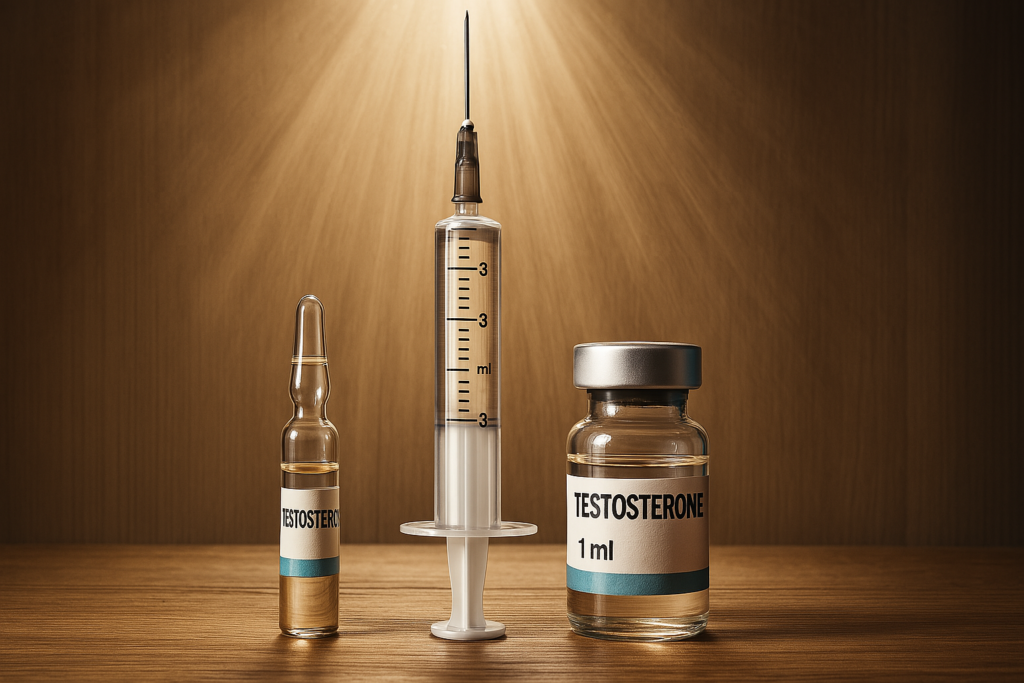
Testosterone replacement therapy comes in several forms, each with unique advantages and considerations. Understanding these options will help you make an informed decision with your healthcare provider.
Injectable Testosterone
Injectable testosterone is the most common and often most effective form of TRT. It provides precise dosing control and reliable absorption.
Types of Injectable Testosterone:
- Testosterone Cypionate
- Most common in the United States
- Half-life of 8-10 days
- Typically injected once or twice weekly
- Generally affordable, even without insurance
- Testosterone Enanthate
- Similar to cypionate with minor chemical differences
- Half-life of 7-9 days
- Slightly faster release than cypionate
- Some men report subtle differences in how they feel between these esters
- Testosterone Propionate
- Much shorter half-life (2-3 days)
- Requires more frequent injections (every 2-3 days)
- Faster onset of action
- More frequent peaks and valleys in blood levels
- Higher risk of post-injection pain
Injection Frequencies:
- Traditional Protocol: Once every 1-2 weeks (creates significant peaks and valleys)
- Split Dose Protocol: Twice weekly (more stable levels)
- Frequent Dose Protocol: Every other day or daily (most stable levels)
More frequent injections generally produce more stable hormone levels, which can mean fewer side effects and more consistent benefits.
Injection Methods:
- Intramuscular (IM): Traditional method using larger needles (22-25 gauge) into muscle tissue, typically the glute or thigh
- Subcutaneous (SubQ): Newer method using smaller needles (27-30 gauge) into fat tissue, typically the abdomen or love handles
- Shallow IM: A middle ground between the two, injecting into the muscle layer just below the fat
Pros of Injectable Testosterone:
- Most effective at raising testosterone levels
- Precise dosing control
- Reliable absorption
- Most cost-effective option
- Flexible administration frequency
- Not affected by showering or swimming
- No risk of transfer to others
Cons of Injectable Testosterone:
- Requires comfort with needles
- More invasive than topical options
- Potential for post-injection pain
- Risk of improper injection technique
- Some men dislike regular injections
Testosterone Gels and Creams
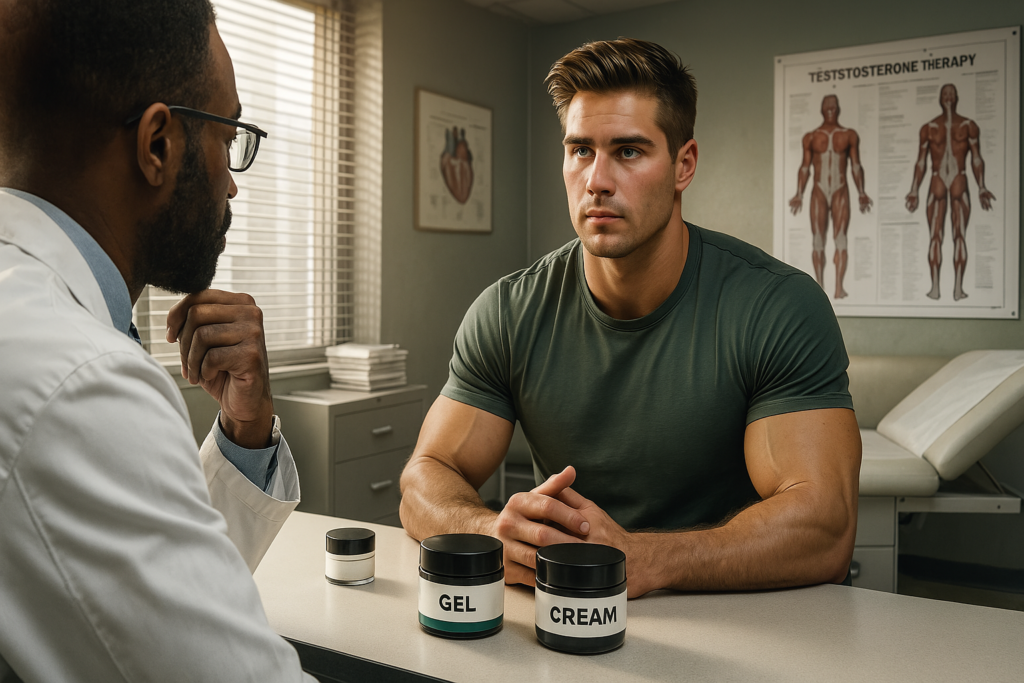
Testosterone gels and creams are applied to the skin daily, where the hormone is absorbed through the skin into the bloodstream.
Common Brands:
- AndroGel
- Testim
- Fortesta
- Various compounded formulations
Application Methods:
- Applied to clean, dry skin, typically shoulders, upper arms, or abdomen
- Must be allowed to dry before dressing
- Hands should be washed thoroughly after application
- Application sites should be covered to prevent transfer to others
Pros of Testosterone Gels/Creams:
- No needles required
- Daily application provides relatively stable levels
- Easy to use
- Non-invasive
- Can be discontinued immediately if needed
Cons of Testosterone Gels/Creams:
- Risk of transfer to women and children through skin contact
- Variable absorption affected by skin properties, showering, and sweating
- Typically more expensive than injections
- Less reliable at maintaining optimal levels for many men
- Must be applied daily at the same time
- May cause skin irritation
- Cannot swim or shower soon after application
Testosterone Pellets
Testosterone pellets are rice-sized implants inserted under the skin (usually in the hip area) that slowly release testosterone over 3-6 months.
Procedure:
- Minor in-office procedure with local anesthesia
- Pellets placed under the skin through a small incision
- Typically takes 15-20 minutes
- Lasts 3-6 months depending on metabolism
Pros of Testosterone Pellets:
- No need to remember daily or weekly treatments
- Provides relatively stable hormone levels
- Convenient (3-4 treatments per year)
- No risk of transfer to others
- No visible evidence of treatment
Cons of Testosterone Pellets:
- Requires minor surgical procedure
- Cannot easily adjust dosage once inserted
- If side effects occur, pellets are difficult to remove
- Some men report “roller coaster” effect as pellets wear off
- Potential for pellet extrusion through the skin
- More expensive than many other options
- Less flexibility in protocol management
Oral Testosterone Options
Oral testosterone options are less common for long-term TRT due to efficacy and safety concerns.
Types of Oral Testosterone:
- Testosterone Undecanoate (Jatenzo, Andriol)
- Absorbed through the lymphatic system
- Must be taken with fatty meals
- Multiple daily doses required
- Not widely available in the US until recently
- Methylated Testosterone (rarely used)
- Passes through the liver before entering circulation
- Associated with liver toxicity
- Not recommended for long-term use
Pros of Oral Testosterone:
- No injections or topical application
- Convenient pill form
- Easy to discontinue if needed
Cons of Oral Testosterone:
- Less effective than other methods for many men
- Potential liver stress or toxicity with some formulations
- Multiple daily doses often required
- Must be taken with food for proper absorption
- More expensive than injectable options
- Less reliable at maintaining stable levels
Making the Right Choice
The best administration method varies based on individual preferences, lifestyle, and medical considerations. Many factors should influence your decision:
Consider Injectable Testosterone If:
- You want the most effective and reliable option
- Cost is a significant factor
- You’re comfortable with self-injection
- You want precise control over your protocol
- You don’t mind administering treatment regularly
Consider Testosterone Gel/Cream If:
- You have needle phobia
- You prefer daily administration
- You don’t have children or female partners who might be accidentally exposed
- You can afford the higher cost
Consider Testosterone Pellets If:
- Convenience is your top priority
- You prefer not thinking about treatment for months at a time
- You don’t mind the higher cost
- Your levels are already stable and you know your optimal dose
- You don’t anticipate needing dose adjustments
Ultimately, injectable testosterone is the most popular option among experienced TRT patients due to its combination of effectiveness, cost, and flexibility. However, the right choice is the one that fits best with your personal preferences and lifestyle.
Starting TRT: What to Expect
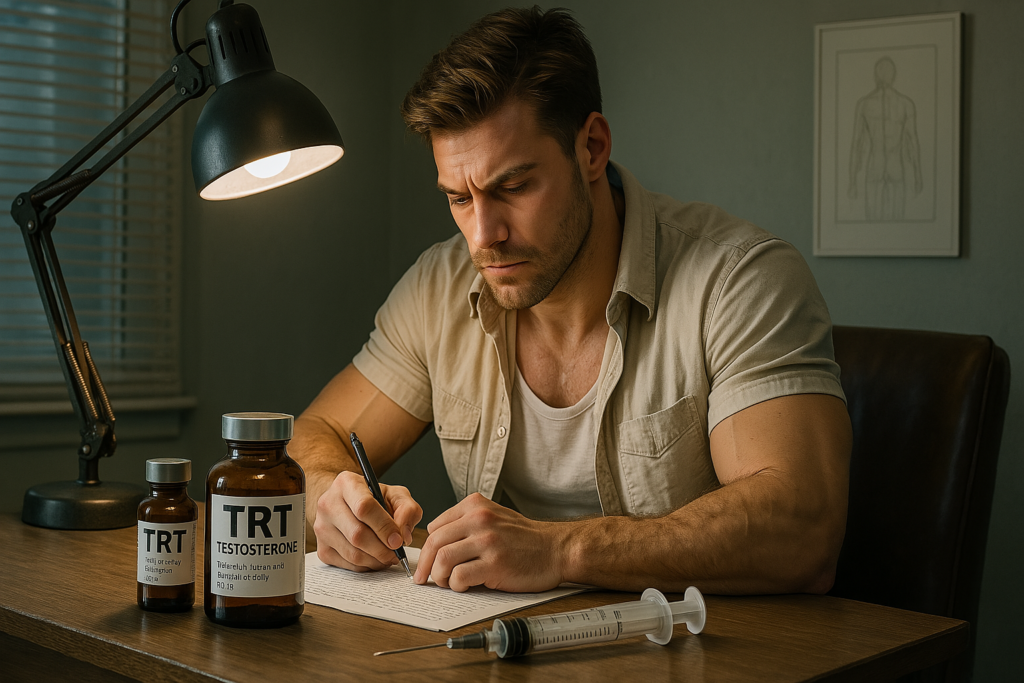
Beginning testosterone replacement therapy is an important step that requires preparation and realistic expectations. Here’s what you should know as you start your TRT journey.
Initial Consultation Process
Your first appointment with a TRT provider typically includes:
Medical History Review
- Detailed discussion of your symptoms
- Review of any previous hormone testing
- Complete medical history, including medications and supplements
- Family history of relevant conditions
Physical Examination
- Vital signs (blood pressure, weight, etc.)
- Examination of body composition
- Testicular examination
- Check for gynecomastia (male breast tissue)
- Other relevant physical assessments
Laboratory Testing
- Comprehensive hormone panel (as detailed in earlier sections)
- Baseline health markers
- Additional testing based on your specific situation
Treatment Discussion
- Review of test results and diagnosis
- Explanation of treatment options
- Discussion of benefits and potential risks
- Setting of realistic expectations
- Creation of an initial treatment plan
Education and Training
- For injectable testosterone: injection demonstration and practice
- For gels/creams: proper application techniques
- Explanation of monitoring schedule
- Discussion of potential side effects and management
Baseline Labs and Monitoring
Before starting TRT, comprehensive blood work provides a baseline for comparison. Your doctor should check:
Hormone Levels:
- Total and free testosterone
- Estradiol (E2)
- SHBG
- LH and FSH
- Prolactin
- Thyroid hormones
General Health Markers:
- Complete blood count (CBC)
- Comprehensive metabolic panel (liver and kidney function)
- Lipid panel (cholesterol)
- PSA (for men over 40)
- Vitamin D, B12, and other relevant nutrients
Follow-up Testing Schedule:
- First follow-up: 6-8 weeks after starting TRT
- Subsequent testing: Every 3-6 months during the first year
- Once stable: Every 6-12 months
- More frequent testing if adjustments are made or issues arise
Finding the Right Protocol
Starting doses are standardized, but optimal treatment is highly individualized:
Typical Starting Protocols:
- Injectable testosterone cypionate: 100-200mg per week, split into 1-2 doses
- Testosterone cream: 5-20% daily application
- Testosterone pellets: 750-1200mg implanted, lasting 3-6 months
Protocol Refinement:
- Your initial protocol is just a starting point
- Adjustments based on lab results and symptom response
- Finding your optimal protocol often takes 3-6 months
- The goal is symptom relief with minimal side effects, not just hitting certain numbers
Individualization Factors:
- Your body’s metabolism of testosterone
- Tendency to convert testosterone to estrogen
- SHBG levels (affect free testosterone)
- Body composition and weight
- Age and overall health
- Symptom response
- Personal goals for treatment
Adjustment Period and Timeline

TRT is not an overnight fix. The adjustment period includes:
Initial Adjustment (First 4-6 Weeks)
- Your body adapting to new hormone levels
- Possible fluctuations in how you feel
- Some early benefits beginning to appear
- Potential for temporary side effects as your body adjusts
Getting Dialed In (2-6 Months)
- Protocol refinements based on labs and symptoms
- Finding your optimal dose and frequency
- Stabilization of hormone levels
- Progressive improvement in symptoms
Long-term Optimization (6+ Months)
- Fine-tuning for optimal well-being
- Addressing any persistent side effects
- Integrating lifestyle factors for best results
- Establishing long-term monitoring routine
What You Might Experience:
- Early energy improvements
- Gradual mood enhancement
- Progressive improvement in sexual function
- Slow changes in body composition
- Eventual stabilization at your “new normal”
Managing Expectations
Having realistic expectations is crucial for a positive TRT experience:
TRT Is Not a Magic Bullet
- It addresses hormone deficiency but doesn’t fix all health issues
- Results vary significantly between individuals
- Lifestyle factors remain important (diet, exercise, sleep, stress management)
Patience Is Essential
- Some benefits appear quickly, others take months
- Body composition changes are gradual
- Full benefits may take 6-12 months to realize
Balance Is the Goal
- The aim is optimal health, not maximum testosterone
- Higher is not always better
- The sweet spot varies from person to person
Commitment Is Required
- TRT is typically a long-term or lifelong treatment
- Consistency with your protocol is important
- Regular monitoring ensures safety and effectiveness
Remember that starting TRT is the beginning of a process, not an immediate solution. Working closely with a knowledgeable healthcare provider and maintaining patience during the adjustment period will set you up for the best possible outcome.
Monitoring and Optimizing Your TRT Protocol
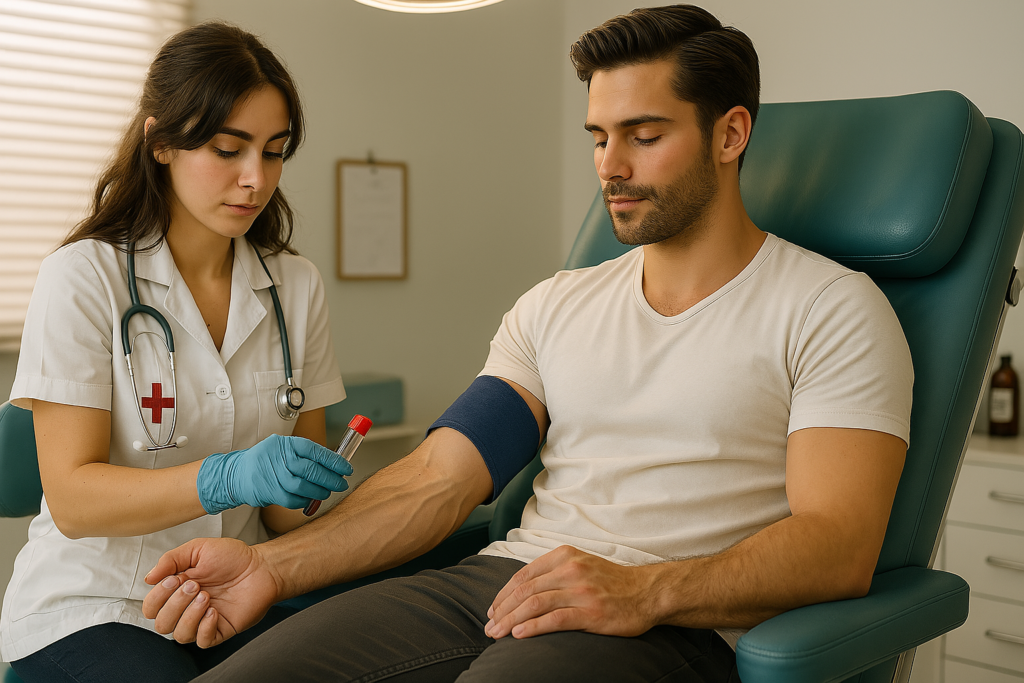
Successful TRT requires ongoing monitoring and adjustment to ensure you’re receiving the optimal benefits while minimizing potential side effects. This section covers the essentials of tracking your progress and fine-tuning your protocol.
Essential Blood Work Parameters
Regular blood tests are the cornerstone of TRT monitoring. Here are the key markers to track:
Primary Hormone Levels:
- Total Testosterone: Overall testosterone level
- Free Testosterone: The biologically active portion
- Estradiol (E2): Main estrogen in men, important for balance
- SHBG: Affects how much testosterone is available to your body
Health and Safety Markers:
- Hematocrit and Hemoglobin: Red blood cell measurements
- Liver Function Tests (ALT, AST): Ensure healthy liver function
- Lipid Panel: Monitor cholesterol and triglycerides
- PSA: Prostate-specific antigen for men over 40
- Blood Pressure: Regularly check at home and during appointments
Additional Valuable Markers:
- Thyroid Panel (TSH, Free T3, Free T4): Thyroid function affects energy
- Vitamin D: Important for testosterone production and overall health
- HbA1c or Fasting Glucose: Monitor metabolic health
- Cortisol: Stress hormone that can impact testosterone function
Optimal Testing Frequency
How often you should test depends on where you are in your TRT journey:
Initial Optimization Phase (First Year):
- Baseline testing before starting
- First follow-up: 6-8 weeks after starting
- Subsequent testing: Every 3 months until stable
- After any protocol change: Retest in 4-6 weeks
Maintenance Phase (After Stabilization):
- Every 6 months is standard
- Annually at minimum once completely stable
- More frequent testing if symptoms change
- Consider quarterly testing if you’ve had previous issues
Testing Timing Considerations:
- For injections: Test at trough (right before your next injection)
- For daily applications: Test 2-4 hours after gel/cream application
- Maintain consistent timing relative to your last dose for comparable results
- Morning testing is preferable for consistency
Understanding Free vs. Total Testosterone

While most lab tests report total testosterone, free testosterone often correlates better with symptoms:
Total Testosterone
- Includes all testosterone in your bloodstream
- Includes testosterone bound to SHBG (unavailable to tissues)
- Easier to measure and more commonly tested
- Reference ranges typically 300-1000 ng/dL in modern labs
Free Testosterone
- Only 2-3% of your total testosterone
- The portion available to bind to receptors in your tissues
- More directly related to symptom improvement
- Often must be calculated rather than directly measured
- Many labs don’t routinely include this crucial measurement
Why Free Testosterone Matters:
- Two men with identical total testosterone can have very different free testosterone levels
- High SHBG can bind up testosterone, leaving little free testosterone
- Low SHBG can mean higher free testosterone despite modest total levels
- Symptoms often correlate better with free testosterone than total
- Optimal ranges for free testosterone are typically 2-3% of total testosterone
SHBG’s Critical Role:
- Higher SHBG = less free testosterone
- Lower SHBG = more free testosterone
- Factors that increase SHBG: aging, thyroid problems, liver disease, low-fat diets
- Factors that decrease SHBG: obesity, insulin resistance, high-carb diets
Key Markers Beyond Testosterone
While testosterone levels are central to TRT monitoring, other markers provide crucial context:
Estradiol (E2)
- Converted from testosterone through aromatization
- Essential for male health in proper amounts
- Affects mood, libido, joints, cardiovascular health, and bone density
- Both too high and too low can cause problems
- Symptoms of high E2: water retention, mood swings, breast tenderness
- Symptoms of low E2: joint pain, low libido, moodiness, cognitive issues
- Optimal range for most men: 20-40 pg/mL, though individual tolerances vary and men on TRT often go higher without symptoms
Hematocrit and Hemoglobin
- Testosterone increases red blood cell production
- Modest increases are normal and expected on TRT
- Excessive elevations may increase blood thickness
- Typical range for hematocrit: 42-52%
- TRT users often run slightly higher (50-54%) without issues
- Should be monitored but not over-treated (more on this in side effects section)
Thyroid Hormones
- Thyroid function affects energy, metabolism, and how you feel on TRT
- Hypothyroidism can cause symptoms similar to low testosterone
- Many men benefit from optimizing both testosterone and thyroid
Metabolic Health Markers
- Insulin resistance can reduce testosterone’s effectiveness
- Blood glucose, insulin, and HbA1c provide insights into metabolic health
- TRT often improves these markers, but they should still be monitored
When and How to Adjust Your Protocol
Protocol adjustments should be based on a combination of lab results and how you feel:
Reasons to Consider Dose Adjustments:
- Persistent symptoms despite treatment
- Lab values outside optimal ranges
- Side effects suggesting imbalances
- Changes in health, weight, or lifestyle
Adjusting Testosterone Dosage:
- Increase if testosterone levels are low and symptoms persist
- Decrease if levels are excessive or side effects occur
- Typical adjustments are 10-20% at a time
- Allow 4-6 weeks between adjustments to assess effects
Adjusting Administration Frequency:
- More frequent, smaller doses often provide more stable levels
- Consider splitting weekly doses into twice weekly
- Consider every-other-day or daily micro-doses for optimal stability
- Frequent injections often reduce side effects like mood swings and energy fluctuations
Adjustment Process:
- Make only one change at a time
- Document the change and any effects
- Retest after 4-6 weeks
- Assess both lab values and symptoms
- Make additional adjustments if needed
Remember that optimization is a process, not an event. Fine-tuning your protocol takes time and patience, but the benefits of finding your ideal balance are substantial.
Managing Potential Side Effects

When properly managed, TRT typically causes few side effects. However, being informed about potential issues and their management is important for a successful treatment experience.
Common Side Effects and How to Address Them
Water Retention
- Symptoms: Puffiness, swollen ankles, weight gain, increased blood pressure
- Causes: Often related to elevated estradiol or high doses
- Management:
- Increase injection frequency (smaller, more frequent doses)
- Ensure adequate hydration
- Reduce sodium intake
- Consider mild natural diuretics like dandelion root
- Address estradiol if significantly elevated
Acne
- Symptoms: Increased oiliness, pimples (often on back, shoulders)
- Causes: Hormonal fluctuations, increased oil production
- Management:
- More frequent, smaller doses to stabilize hormone levels
- Improved skincare routine
- Avoid harsh soaps that stimulate oil production
- Consider zinc supplementation
- For severe cases, consult a dermatologist
Mood Swings
- Symptoms: Irritability, emotional volatility, anxiety
- Causes: Hormone fluctuations, estrogen imbalance
- Management:
- More frequent dosing for stable levels
- Check estradiol (both high and low can cause mood issues)
- Ensure adequate sleep and stress management
- Assess thyroid function
- Consider magnesium supplementation
Hair Shedding
- Symptoms: Temporary increase in hair shedding
- Causes: Hormonal shifts, DHT conversion
- Management:
- Usually temporary and resolves as hormones stabilize
- Maintain consistent protocol (avoid fluctuations)
- Rule out thyroid issues, which can also cause shedding
Testicular Atrophy
- Symptoms: Reduction in testicular size
- Causes: Natural result of external testosterone suppressing LH/FSH
- Management:
- HCG (human chorionic gonadotropin) can maintain testicular size
- Discuss with your provider if this is a concern
- Important consideration if fertility is desired
Hematocrit Management
One of the most commonly discussed side effects of TRT is increased hematocrit (percentage of red blood cells in your blood). Here’s what you need to know:
Understanding Hematocrit on TRT:
- Testosterone naturally stimulates red blood cell production
- Modest increases in hematocrit (2-4%) are normal and expected
- TRT users often operate safely in the 50-54% range
- Traditional medical ranges were developed for non-TRT populations
- Many high-altitude populations live healthily with hematocrit over 55%
The Truth About Hematocrit:
- Symptoms and overall context matter more than a specific number
- TRT-induced erythrocytosis is not the same as polycythemia vera (a blood disease)
- The often-cited danger threshold of 54% lacks strong evidence for TRT users
- Most TRT specialists consider the high zone to be 54-57%
- Intervention should be based on symptoms and individual risk factors, not just numbers
Key Factors to Consider:
- Hydration status dramatically affects hematocrit readings
- Other blood markers like platelets and inflammatory markers
- Presence or absence of symptoms
- Cardiovascular risk factors
- Sleep apnea status
Sensible Management Approach:
- First-line strategies (if hematocrit is elevated but asymptomatic):
- Ensure proper hydration (dehydration can falsely elevate readings)
- Increase injection frequency to smaller, more frequent doses
- Regular cardiovascular exercise
- Screen for and treat sleep apnea if present
- Reduce iron intake if ferritin is high
- When to consider blood donation:
- Hematocrit consistently above 57%
- Presence of symptoms (headaches, flushing, vision changes)
- Other concerning blood markers or risk factors
- NOT solely based on numbers in the low 50s without symptoms
Drawbacks of Excessive Blood Donation:
- Can deplete iron stores (ferritin)
- May cause fatigue and weakness
- Often leads to rapid rebound increases in hematocrit
- Can become a cycle of donation and rebound
Estradiol Balance
Estradiol (E2) is often misunderstood in TRT. Here’s the evidence-based approach to managing this important hormone:
The Truth About Estradiol in Men:
- Estradiol is essential for male health, not something to fear
- It plays critical roles in brain, bone, cardiovascular, and sexual health
- When testosterone increases, some conversion to estradiol is normal and necessary
- Both too high AND too low estradiol can cause problems
Signs of Estradiol Imbalance:
Too High Estradiol:
- Water retention
- Breast tenderness or swelling
- Emotional volatility
- Excessive nipple sensitivity
Too Low Estradiol:
- Joint pain and cracking
- Mood flatness or depression
- Decreased libido
- Memory issues
- Bone density concerns long-term
Sensible Management Approach:
- First-line strategies for elevated estradiol:
- Lower testosterone dose if levels are excessive
- Increase injection frequency (smaller, more frequent doses)
- Reduce body fat (fat tissue converts testosterone to estrogen)
- Improve insulin sensitivity and metabolic health
- Consider natural supports like zinc, vitamin E, and cruciferous vegetables
- The truth about Aromatase Inhibitors (AIs):
- AIs like anastrozole are NOT routinely necessary despite common practice
- They should be considered only when estradiol is significantly elevated AND causing clear symptoms
- AIs can cause joint pain, mood issues, and bone density loss when overused
- Only about 3% of TRT patients truly need an AI long-term
- If used, they should be prescribed at the lowest effective dose
- Regular monitoring is essential if AIs are used
The Estradiol Sweet Spot:
- Most men feel best with estradiol between 20-40 pg/mL
- Individual tolerance varies significantly
- Managing by symptoms is more important than specific numbers
- Focus on the testosterone-to-estradiol ratio rather than absolute values
Fertility Considerations

TRT typically suppresses natural testosterone production and sperm development, which can impact fertility:
Effects on Fertility:
- Reduced or eliminated sperm production while on standard TRT
- Varying recovery times if TRT is discontinued
- Some men may not fully recover previous fertility
- Impact increases with duration of treatment
Options for Preserving Fertility:
- HCG (Human Chorionic Gonadotropin): Mimics LH and can maintain testicular function
- HMG (Human Menopausal Gonadotropin): Can be added for more comprehensive fertility support
- Sperm Banking: Consider before starting TRT if future fertility is a concern
- Fertility-Preserving Protocols: Specialized approaches combining testosterone with fertility medications
Planning Considerations:
- Discuss fertility goals with your provider before starting TRT
- Consider sperm analysis before and during treatment if fertility is a concern
- Know that fertility preservation adds complexity and cost to treatment
- Understand that complete fertility preservation is not guaranteed with any approach
Blood Pressure Monitoring
Testosterone can affect blood pressure in various ways:
Potential Impacts:
- TRT may increase blood pressure in some men
- Often related to water retention or increased red blood cell production
- Some men actually experience improved blood pressure on TRT
- Individual responses vary considerably
Monitoring Recommendations:
- Check blood pressure before starting TRT (baseline)
- Regular home monitoring during treatment optimization
- Blood pressure checks at all provider visits
- More frequent monitoring if you have pre-existing hypertension
Management Strategies:
- Optimize injection frequency for stable hormone levels
- Address excessive estradiol if present
- Maintain healthy sodium intake
- Regular aerobic exercise
- Consider supplements that support healthy blood pressure (magnesium, CoQ10)
- Medication may be necessary in some cases
Remember that most side effects of TRT are manageable with proper protocol adjustments and lifestyle measures. Working with a knowledgeable provider who takes a balanced, evidence-based approach to side effect management is crucial for a positive experience.
Lifestyle Factors That Enhance TRT

While testosterone replacement therapy can significantly improve your quality of life, its benefits are maximized when combined with healthy lifestyle practices. These complementary strategies can enhance your results and potentially allow for lower medication doses.
Nutrition Guidelines
What you eat plays a crucial role in optimizing your hormone response and overall health:
Protein Intake:
- Aim for 0.8-1.2g of protein per pound of lean body mass
- Prioritize complete protein sources (meat, fish, eggs, dairy)
- Distribute protein intake throughout the day
- Adequate protein supports muscle growth, recovery, and metabolic health
Healthy Fat Balance:
- Include sufficient dietary fat (25-35% of calories)
- Prioritize monounsaturated fats (olive oil, avocados)
- Include omega-3 fatty acids (fatty fish, walnuts, flaxseeds)
- Moderate saturated fat from quality sources
- Dietary fat is essential for hormone production
Carbohydrate Considerations:
- Individualize based on activity level and metabolic health
- Focus on fiber-rich, minimally processed sources
- Time carbs around exercise for best results
- Monitor effect on energy, body composition, and blood markers
Food Quality:
- Emphasize whole, minimally processed foods
- Choose organic when possible to minimize pesticide exposure
- Select pastured/grass-fed animal products when available
- Limit artificial ingredients and highly processed foods
Specific Considerations for Hormone Health:
- Limit alcohol (can increase aromatization of testosterone to estrogen)
- Be cautious with excessive soy intake (moderate amounts are fine for most)
- Include zinc-rich foods (oysters, beef, pumpkin seeds)
- Consider cruciferous vegetables to support healthy estrogen metabolism
- Stay well-hydrated (affects hormone transport and blood viscosity)
Exercise Recommendations

Physical activity is a powerful complement to TRT, enhancing its effects while providing additional health benefits:
Resistance Training:
- Aim for 3-4 strength training sessions weekly
- Include compound movements (squats, deadlifts, presses, rows)
- Progressive overload (gradually increasing weight/volume)
- TRT enhances recovery and results from strength training
- Resistance training increases testosterone receptor sensitivity
Cardiovascular Exercise:
- Include 2-3 sessions of heart-healthy cardio weekly
- Mix intensities (both moderate steady-state and interval training)
- 20-30 minutes per session is often sufficient
- Helps manage hematocrit levels
- Improves insulin sensitivity and heart health
- Excessive cardio can be counterproductive
Recovery Considerations:
- TRT improves recovery, but doesn’t eliminate the need for it
- Ensure adequate rest between training sessions
- Listen to your body and adjust training volume as needed
- Sleep is a critical component of exercise recovery
Exercise Timing:
- Training in the afternoon or evening may be optimal for most
- Post-exercise nutrition becomes more important on TRT
- Consistency matters more than perfect timing
Sleep Optimization
Sleep quality significantly impacts how you feel and respond to TRT:
Sleep Duration:
- Aim for 7-9 hours of quality sleep
- Insufficient sleep can lower testosterone and increase stress hormones
- Recovery from exercise and daily stressors occurs during sleep
Sleep Quality Strategies:
- Maintain consistent sleep/wake times
- Create a cool, dark, quiet sleeping environment
- Limit blue light exposure before bed (phones, computers, TVs)
- Consider sleep tracking to identify issues
- Address sleep apnea if present (common in men with low T)
Sleep Apnea Awareness:
- TRT may worsen sleep apnea in predisposed individuals
- Symptoms include snoring, gasping, daytime fatigue
- Consider screening for sleep apnea before starting TRT
- Monitor for sleep quality changes during treatment
- Treating sleep apnea often improves testosterone levels naturally
Stress Management
Chronic stress can undermine the benefits of TRT:
Impact of Stress:
- Elevates cortisol, which opposes testosterone’s actions
- Affects sleep quality
- Increases inflammation
- Can lead to comfort eating and poor food choices
Effective Stress Management Strategies:
- Regular meditation or mindfulness practice (even 10 minutes daily)
- Time in nature
- Breathwork techniques
- Setting appropriate boundaries
- Regular leisure activities
- Social connection
- Consider adaptogens like ashwagandha if appropriate
Supplements That Complement TRT

While supplements can’t replace proper TRT, certain ones may enhance your overall results:
Foundation Supplements:
- Vitamin D3 (2000-5000 IU daily) – Many men are deficient
- Magnesium (200-400mg daily) – Supports numerous biological processes
- Zinc (15-30mg daily) – Important for hormone production
- Omega-3 fatty acids (1-3g combined EPA/DHA) – Supports overall health
Supporting Supplements to Consider:
- Vitamin K2 (pairs well with D3 for bone and cardiovascular health)
- CoQ10 (especially if on statin medications)
- Boron (may help optimize free testosterone)
- Ashwagandha (may help manage stress and support hormone balance)
Approach to Supplementation:
- Start with the essentials based on your specific needs
- Test for deficiencies when possible
- Quality matters – choose reputable brands
- More is not better – follow recommended dosages
- Supplements should complement, not replace, proper nutrition
Supplements to Approach with Caution:
- DHEA (can convert to both testosterone and estrogen)
- High-dose vitamin E (controversial research on health effects)
- Testosterone “boosters” (largely ineffective once on TRT)
Remember that lifestyle factors work synergistically with TRT. Improving your nutrition, exercise, sleep, and stress management can significantly enhance your results while potentially allowing for lower medication doses and fewer side effects.
Choosing a TRT Provider
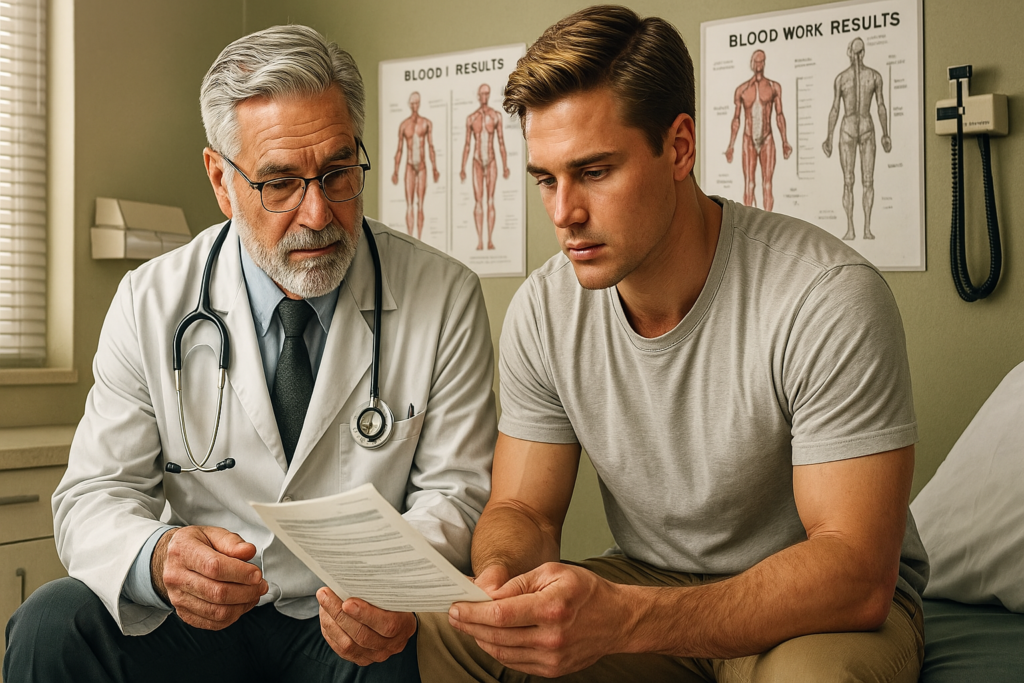
Finding the right healthcare provider is one of the most critical decisions you’ll make in your TRT journey. The quality of care varies dramatically, and the right provider can make the difference between merely adequate results and truly optimized health.
Types of Providers
Several different types of medical professionals offer testosterone replacement therapy, each with potential advantages and limitations:
Urologists
- Strengths: Specialists in male reproductive health, surgical options if needed
- Limitations: Many focus primarily on erectile dysfunction rather than comprehensive hormone optimization
- Best for: Men with specific urological conditions alongside low testosterone
Endocrinologists
- Strengths: Extensive training in hormone systems
- Limitations: Often focus on diabetes and thyroid disorders; many are conservative with testosterone therapy and target only “low normal” levels
- Best for: Men with complex hormonal issues beyond just testosterone
Primary Care Physicians
- Strengths: Convenience, established relationship, insurance coverage
- Limitations: Often limited experience with optimal TRT protocols, may be restricted by practice guidelines
- Best for: Basic TRT when finances are limited and when the doctor is willing to learn
Men’s Health Clinics
- Strengths: Focus specifically on testosterone and men’s hormonal health, more progressive protocols, more comprehensive monitoring
- Limitations: Higher cost, often not covered by insurance, quality varies significantly
- Best for: Men seeking optimization rather than just reaching minimal standards
Integrative/Functional Medicine Doctors
- Strengths: Holistic approach considering multiple body systems, typically more open to optimization
- Limitations: Variable expertise specifically in TRT, may emphasize other treatments over medication
- Best for: Men seeking a whole-body approach to their hormonal health
Telemedicine TRT Providers
- Strengths: Convenience, often more affordable than specialized clinics, can access doctors outside your geographic area
- Limitations: Limited physical examination, lab work must be coordinated locally
- Best for: Men in areas with limited local options, those with busy schedules
Questions to Ask Potential Providers
Before committing to a provider, consider asking these questions:
- Experience and Philosophy
- “How many TRT patients do you treat?”
- “What is your approach to testosterone optimization versus just reaching ‘normal’ ranges?”
- “How do you determine dosing – by lab numbers alone or symptoms as well?”
- Protocol Approach
- “What testosterone delivery methods do you typically prescribe and why?”
- “What is your approach to injection frequency?”
- “Do you prescribe medications beyond testosterone (HCG, AIs) when needed?”
- “How do you monitor and manage potential side effects?”
- Testing and Monitoring
- “What specific lab tests do you include in monitoring?”
- “How often do you recommend testing, especially during the initial optimization phase?”
- “Do you test free testosterone or just total?”
- “Do you include estradiol testing in your monitoring?”
- Accessibility and Support
- “How available are you between appointments for questions or concerns?”
- “What is your typical response time for medication adjustments?”
- “Do you provide education materials or resources for patients?”
- Practical Considerations
- “What are your typical costs for consultation, follow-ups, and lab work?”
- “Do you work with insurance for any aspects of treatment?”
- “What is your policy if I need to travel or miss appointments?”
Red Flags to Watch For
Be cautious if a provider displays these warning signs:
- One-size-fits-all protocols without individualization
- Reluctance to address questions or dismissive of your concerns
- Unwillingness to test comprehensive labs (e.g., only testing total testosterone)
- Automatic prescription of AIs for all patients regardless of estradiol levels
- Focusing solely on testosterone levels without considering related hormones
- Resistance to more frequent injections despite your interest
- Unwillingness to treat symptoms if your numbers are “in range”
- Excessive focus on potential risks without balanced discussion of benefits
- Using outdated ranges and references rather than current research
- Inadequate follow-up and monitoring
Insurance and Cost Considerations

TRT can vary dramatically in cost depending on your approach:
Insurance-Based Treatment
- Coverage varies widely between plans
- Typically requires documented low testosterone levels (often below 300 ng/dL)
- May only cover certain medications and delivery methods
- Usually limits testing frequency
- Co-pays and deductibles apply
- Advantage: Lower out-of-pocket costs
- Disadvantage: Often restricted to basic protocols
Self-Pay Options
- Men’s clinics: Typically $150-400 monthly including consultations and medications
- Telemedicine providers: Often $100-250 monthly
- Compounded medications can sometimes reduce costs
- Lab work can be obtained through discount services
- Advantage: More flexibility in treatment approach
- Disadvantage: Higher upfront costs
Cost-Saving Strategies
- Ask about cash prices for medications (sometimes cheaper than insurance co-pays)
- Consider GoodRx or similar discount programs for prescriptions
- Some labs offer substantial discounts for cash-paying patients
- Telemedicine can eliminate travel costs and time off work
- Once stable, negotiate less frequent visits with your provider
Telehealth vs. In-Person Treatment Options
The growth of telemedicine has expanded options for TRT treatment:
Telehealth Advantages:
- Access to specialists regardless of location
- More convenient for busy schedules
- Often more affordable than specialized in-person clinics
- No travel or waiting room time
- May offer more flexible scheduling
Telehealth Limitations:
- Physical examination is limited or impossible
- Lab work must be coordinated separately
- Some states have restrictions on telemedicine prescribing
- Some people prefer face-to-face interaction
- May not be suitable for complex cases requiring hands-on assessment
Hybrid Approaches:
- Initial consultation in-person, follow-ups via telemedicine
- Local lab work with remote doctor interpretation
- Local primary care for general health, specialist telemedicine for TRT
Choosing What’s Right for You:
- Consider your comfort with technology
- Evaluate local options versus telemedicine possibilities
- Factor in convenience and cost
- Think about whether your case has complexities requiring in-person assessment
Remember that finding the right provider is worth the effort. A knowledgeable, responsive healthcare professional who takes a balanced approach to TRT can make a tremendous difference in your results and overall experience.
TRT Myths and Misconceptions

The field of testosterone replacement therapy is unfortunately filled with misinformation. Let’s address some of the most common myths that can lead men astray in their treatment decisions.
TRT vs. Anabolic Steroid Use
Perhaps the most persistent myth is the conflation of therapeutic testosterone replacement with anabolic steroid abuse:
The Truth:
- TRT aims to restore testosterone to normal physiological levels
- Anabolic steroid use typically involves multiple compounds at supraphysiological doses
- TRT is medically supervised with regular monitoring
- TRT brings deficient levels to optimal range; steroid cycles push beyond natural limits
- Studies show properly administered TRT has an excellent safety profile
What People Get Wrong:
- Confusing media coverage of sports doping with medical treatment
- Assuming all testosterone use leads to aggression or “roid rage”
- Believing TRT causes the same side effects as steroid abuse
- Thinking TRT is just for bodybuilders or athletes
The Aromatase Inhibitor Myth
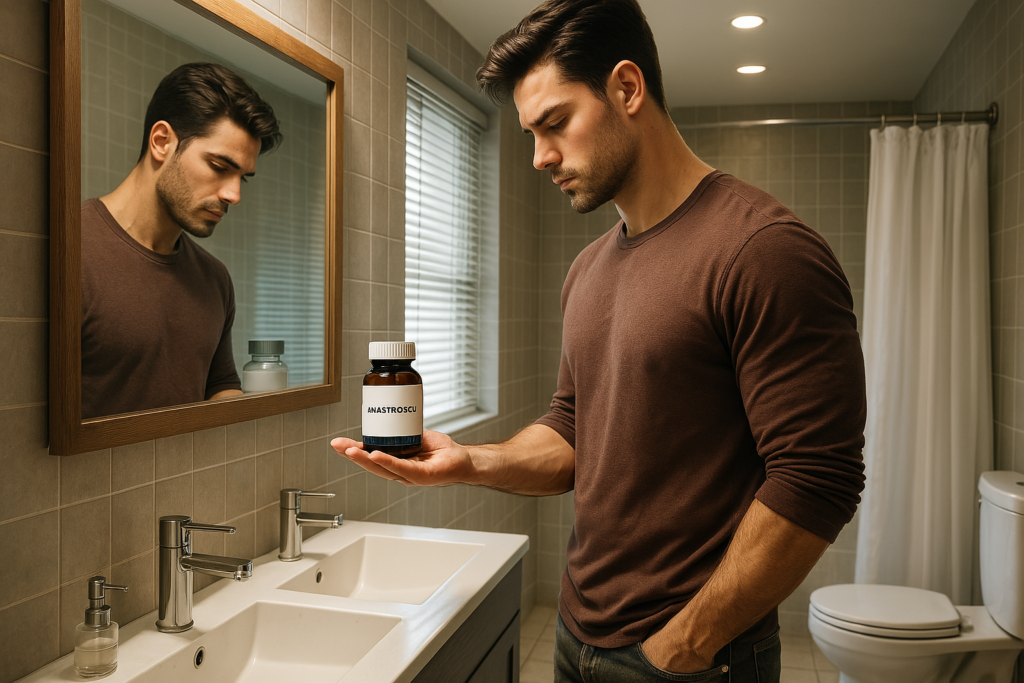
One of the most common mistakes in TRT protocols is the routine prescription of aromatase inhibitors (AIs):
The Myth: All men on TRT need an AI to prevent estrogen-related side effects.
The Truth:
- Estradiol (E2) is essential for male health, not something to be automatically suppressed
- Only about 15-20% of men on TRT develop elevated estradiol levels
- Of those, only a fraction (approximately 3% of TRT patients) actually need an AI
- Many symptoms attributed to “high estrogen” are actually caused by hormone fluctuations or other factors
- AIs can cause serious side effects including joint pain, mood disorders, and bone density loss
- First-line management of elevated estradiol should include:
- Adjusting testosterone dosage and frequency
- Reducing body fat
- Improving metabolic health
- Only considering an AI if these measures fail AND symptoms persist
The Balanced Approach:
- Monitor estradiol as part of regular lab work
- Assess symptoms, not just numbers
- Consider an AI only when estradiol is significantly elevated AND causing clear symptoms
- If an AI is necessary, use the lowest effective dose
- Regularly reassess the need for ongoing AI use
The Blood Donation Myth
Another common misconception involves the management of hematocrit (percentage of red blood cells):
The Myth: All men on TRT need regular blood donation or therapeutic phlebotomy to prevent dangerous blood thickening.
The Truth:
- Modest increases in hematocrit (2-4%) are a normal physiological response to TRT
- The often-cited danger threshold of 54% lacks strong evidence for otherwise healthy TRT patients
- Many TRT specialists consider the high zone to be 54-57%
- High-altitude populations naturally maintain hematocrit in the mid-50s without health issues
- Symptoms and overall context matter more than any specific number
- Dehydration can significantly elevate hematocrit readings (by 2-3 points)
- Frequent blood donation can cause:
- Iron deficiency
- Fatigue and weakness
- Rebound increases in hematocrit
- A cycle of donation and rebound
The Balanced Approach:
- Monitor hematocrit as part of regular labs
- Consider hydration status when interpreting results
- Try conservative approaches first:
- Ensure proper hydration
- Increase injection frequency
- Regular cardiovascular exercise
- Address sleep apnea if present
- Consider blood donation only when:
- Hematocrit is consistently above 57%
- Symptoms are present (headaches, flushing, vision changes)
- Other concerning blood markers or risk factors exist
Longevity and Cardiovascular Concerns
Concerns about cardiovascular health and longevity often deter men from beneficial TRT:
The Myth: TRT increases risk of heart attacks, strokes, and early death.
The Truth:
- Early flawed studies suggested cardiovascular risks
- More recent, better-designed research shows properly administered TRT may actually:
- Improve cholesterol profiles
- Reduce insulin resistance
- Lower inflammation markers
- Improve vascular function
- Potentially reduce cardiovascular mortality in deficient men
- Low testosterone itself is associated with increased cardiovascular risk
- Proper monitoring and protocol design are key to safety
- Balanced hormone levels support overall health and longevity
Important Considerations:
- Individual risk factors matter
- Proper administration and monitoring are essential
- Both too high AND too low testosterone may increase health risks
- Optimizing rather than maximizing is the goal
Prostate Health Facts
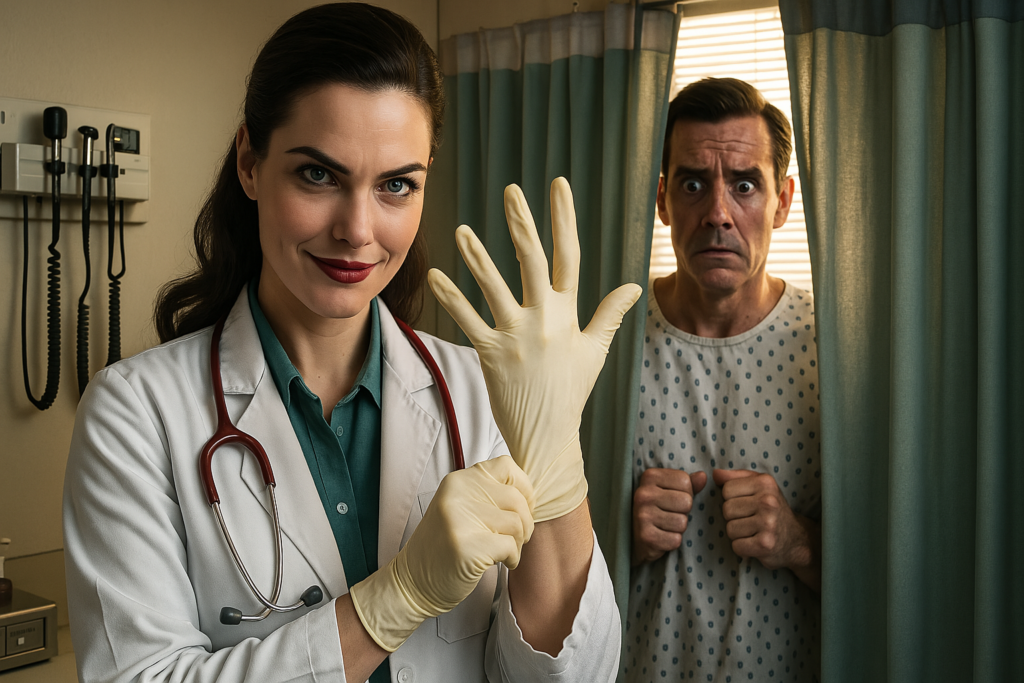
Many doctors still believe testosterone therapy increases prostate cancer risk:
The Myth: TRT causes or accelerates prostate cancer growth.
The Truth:
- This myth originated from 1940s research that has since been disproven
- Modern research shows no causal link between TRT and prostate cancer development
- The “saturation model” explains why TRT doesn’t increase risk – prostate tissue is already saturated with testosterone at normal levels
- Multiple studies show no increase in prostate cancer among TRT patients
- Some men with a history of prostate cancer can safely use TRT after appropriate treatment and monitoring
- Regular prostate monitoring is still important as part of overall men’s health
The Balanced Approach:
- Baseline PSA testing before starting TRT
- Regular PSA monitoring during treatment
- Digital rectal examination as appropriate for age
- Normal age-related prostate health precautions
Evidence-Based Perspective on Risks
A balanced view of TRT recognizes both benefits and potential risks:
Actual Risks of Properly Administered TRT:
- Suppression of natural testosterone production (expected)
- Reduced fertility while on treatment (expected)
- Potential for mild to moderate hematocrit elevation (manageable)
- Sleep apnea exacerbation in predisposed individuals
- Acne or skin oiliness in some men
- Potential fluid retention
Risks That Are Often Exaggerated:
- Cardiovascular events
- Prostate issues
- Liver problems (with proper medication forms)
- Aggression or mood disorders
- Hair loss (TRT may accelerate but doesn’t cause male pattern baldness)
Risk Minimization Strategies:
- Proper patient selection
- Comprehensive baseline testing
- Regular monitoring
- Appropriate dosing (optimizing, not maximizing)
- Lifestyle modifications
- Educated provider supervision
The field of TRT continues to evolve as research improves our understanding of testosterone’s effects. Working with a knowledgeable provider who stays current with emerging evidence is your best protection against outdated practices and misconceptions.
Alternative Routes to TRT

While traditional medical channels are the recommended approach to TRT, it’s important to acknowledge that men access testosterone through various routes. Understanding the complete landscape helps you make informed decisions.
Standard Medical Routes
The conventional path through the healthcare system:
Primary Care Physicians
- Process: Discuss symptoms, get lab work, receive prescription if indicated
- Pros: Insurance coverage, established medical relationship, continuity of care
- Cons: Often limited knowledge of optimal protocols, may be reluctant to prescribe, target only minimum standards
Specialists (Urologists/Endocrinologists)
- Process: Referral from primary care, specialized assessment, prescription if indicated
- Pros: More extensive knowledge of hormonal systems, can address related conditions
- Cons: Often long wait times, may still follow conservative guidelines, can be expensive even with insurance
Getting the Most from Standard Medical Routes:
- Educate yourself before appointments
- Bring research articles if needed
- Request complete hormone panels, not just total testosterone
- Be clear about your symptoms and their impact on quality of life
- Seek second opinions if necessary
Men’s Health Clinics
Specialized clinics focusing specifically on testosterone and men’s health:
Types of Clinics:
- Independent specialized practices
- Franchise operations
- Telemedicine-based services
Process:
- Initial consultation (in-person or virtual)
- Comprehensive lab work
- Protocol design based on results and symptoms
- Regular monitoring and adjustments
- Typically monthly or quarterly fees
Pros:
- Focus specifically on men’s hormonal health
- More aggressive optimization (vs. minimal standards)
- More comprehensive testing
- Often more flexible protocols
- Experience with various delivery methods
Cons:
- Typically not covered by insurance
- Higher costs ($150-400 monthly is common)
- Quality varies significantly between providers
- Some use cookie-cutter approaches
- Some prioritize profit over individualized care
Finding a Quality Clinic:
- Research patient reviews thoroughly
- Ask about their approach to individualization
- Inquire about the medical director’s background and training
- Verify they perform comprehensive testing
- Check if they offer options beyond just testosterone
- Ask if protocols are adjusted based on both symptoms and labs
DIY/Black Market TRT

While not recommended, especially for beginners, some men pursue self-administered TRT:
Important Cautions:
- Legal risks: Possession of testosterone without a prescription is illegal in many jurisdictions
- Quality concerns: Underground products may be contaminated, underdosed, or mislabeled
- Safety issues: Lack of medical oversight poses significant health risks
- Testing limitations: Self-ordered labs provide limited insight without proper interpretation
- Self-management challenges: Proper protocol design and adjustment require expertise
Why Some Men Choose This Route:
- Inability to find knowledgeable providers
- Insurance restrictions or financial limitations
- Desire for more control over their protocol
- Previous negative experiences with medical system
Harm Reduction Information:
- This approach is NOT recommended for beginners
- Only appropriate for those with significant TRT knowledge and experience
- Requires substantial research and understanding of risks
- Laboratory testing is still essential
- Education about proper injection technique is critical
- Understanding warning signs that require medical attention is crucial
Why Physician-Supervised TRT is Recommended for Beginners
For those new to TRT, professional medical guidance is strongly advised:
Safety Considerations:
- Proper diagnosis ensures you actually need testosterone
- Rule out other conditions with similar symptoms
- Identification of contraindications
- Monitoring for potential side effects
- Professional intervention if complications arise
Effectiveness Factors:
- Proper dosing based on individual needs
- Protocol adjustments based on response
- Management of related hormones (estradiol, thyroid, etc.)
- Integration with other treatments if needed
- Accountability and consistency
Practical Advantages:
- Legal prescription access
- Quality-assured medications
- Professional administration training
- Regular monitoring through appropriate tests
- Documentation of medical necessity
Resources for Those Who Cannot Access Traditional TRT

Some men face significant barriers to conventional treatment:
Accessible Options:
- Telemedicine providers (often more affordable than in-person clinics)
- Direct-pay primary care practices (sometimes more flexible than insurance-based)
- Community health centers (sliding scale fees)
- Clinical trials related to testosterone therapy
- Legitimate online hormone testing services
Educational Resources:
- Medical literature databases (PubMed, Google Scholar)
- Reputable online communities (be cautious of biased information)
- Books by credentialed medical professionals
- Patient advocacy organizations
- University hospital patient information resources
Important Steps:
- Continue seeking knowledgeable medical care
- Document your symptoms thoroughly
- Get comprehensive lab work when possible
- Be persistent in advocating for your health
- Consider saving for proper treatment rather than risking DIY approaches
Conclusion

Testosterone replacement therapy represents a potentially life-changing treatment for men suffering from the effects of low testosterone. When properly administered and monitored, TRT can restore energy, improve mood, enhance body composition, revitalize sexual function, and significantly improve overall quality of life.
Summary of Key Points
Throughout this guide, we’ve covered the essential aspects of TRT:
- The Testosterone Crisis: Modern men face dramatically lower testosterone levels than previous generations, with “normal” ranges continually adjusted downward
- Environmental Factors: Endocrine-disrupting chemicals in our environment contribute to declining testosterone levels
- Diagnosis: Proper testing and symptom evaluation are essential for determining if TRT is appropriate
- Benefits: TRT can improve physical, mental, and sexual health when testosterone deficiency is present
- Administration Options: Various delivery methods exist, each with advantages and limitations
- Starting Treatment: Understanding the adjustment period and setting realistic expectations is important
- Monitoring: Regular blood work and symptom assessment ensure optimal results and safety
- Side Effect Management: Most potential issues can be prevented or addressed through proper protocol design
- Lifestyle Factors: Nutrition, exercise, sleep, and stress management enhance TRT’s effectiveness
- Provider Selection: Finding a knowledgeable healthcare professional is crucial for optimal results
- Myth Busting: Evidence-based approaches have debunked many common misconceptions about TRT
- Treatment Options: While physician-supervised TRT is recommended, various routes exist to treatment
Next Steps for Those Considering TRT
If you’re experiencing symptoms of low testosterone and considering treatment:
- Education: Continue learning from reliable sources about hormonal health
- Testing: Arrange comprehensive hormone testing, preferably through a knowledgeable provider
- Evaluation: Have your results interpreted in the context of your symptoms and overall health
- Provider Search: Find a healthcare professional experienced in hormone optimization
- Treatment Decisions: Weigh the benefits, risks, and options based on your specific situation
- Lifestyle Optimization: Implement supportive nutrition, exercise, sleep, and stress management practices
Resources for Further Learning
To deepen your understanding of testosterone replacement therapy:
- Our comprehensive FAQ page answers specific questions about TRT protocols, management, and common concerns
- Our Detailed Guides and Blog Articles in our knowledge base address specialized topics in greater detail
- Testosterone and hormone optimization books written by medical professionals
- Peer-reviewed research articles on testosterone replacement therapy
- Reputable online communities focused on evidence-based approaches to hormone optimization
Final Thoughts
Testosterone is not just another hormone—it’s fundamental to male health and vitality. Addressing deficiency through proper treatment can transform quality of life for men suffering from the wide-ranging effects of low testosterone.
However, TRT is not a casual undertaking. It requires commitment to proper monitoring, protocol adherence, and lifestyle optimization. The best results come from working with knowledgeable providers, taking an individualized approach, and making decisions based on both scientific evidence and personal experience.
Whether you’re just beginning to investigate your symptoms or looking to optimize an existing protocol, we hope this guide has provided valuable insights to help you make informed decisions about your hormonal health.
Remember that restoring optimal testosterone levels isn’t about pursuing some idealized version of masculinity—it’s about feeling like yourself again and reclaiming the vitality that hormone deficiency may have diminished. With the right approach, TRT can be a safe and effective part of your overall health strategy for years to come.